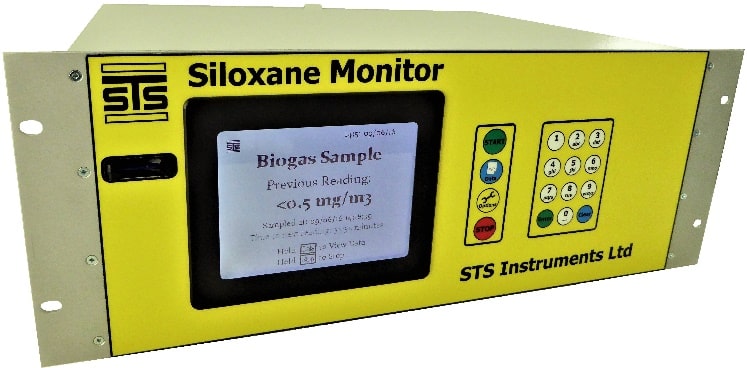MEMBER PRESS RELEASE - Vogelsang to present the HiCone for the wastewater sector at IFAT…

MEMBER’S PRESS RELEASE: Silicone and siloxane use in food preparations
The redirection of food waste streams from landfill to recovery of energy in Combined Heat and Power plant (CHP) is beneficial in that there is less ground pollution from leachate in landfills and at the same time, non-fossil fuel energy is recovered. This operation is therefore beneficial to both the environment and the economy. However, CHP plant running on biogas from food waste anaerobic digestion (AD) processes suffer deposits of silica on engine component surfaces, which is visible as a white deposit. The silica comes from the burning of siloxanes, which are silicon-containing chemicals in the biogas. These chemicals are of low molecular weight and hence volatile at AD operating temperatures. The origin of these siloxanes is currently very unclear in food waste, as is their origins when found, universally, in waste water treatment plant biogas. Suggestions include cosmetics and pharmaceuticals, industrial sealants, detergents, catering and dry-cleaning materials, as well as food additives.
Silicone oils, used in a great many food processing applications, decompose in the AD process to yield siloxanes which pass to the biogas and hence to CHP engines.
Engine Damage
The reason for this study was the failure of several CHP engines running on food waste biogas, when the general understanding was that silica damage, resulting from siloxanes, was limited to landfill and waste water treatment plants. Operational experience has shown otherwise with deposits seen in many engines burning gas from a wide variety of food derived waste.
The consequence of the abrasive silica deposits is well known – damage to pistons, bores, valves and cylinder heads, short oil life, irregular running and increased downtime leading to loss of revenue. In extreme cases, pistons have developed deep scores, valves have suffered blow-by resulting in notches and con rods have penetrated crank cases.
Sources of silicones and siloxanes
Little research appears to have been done on the sources of silicones, which appear to be ubiquitous in the food industry.
Following is a discussion on these sources, gathered from food additive and wrapping manufacturers and from safety and food preparation studies.
Lubricants
Silicone oils, usually in the form of linear PDMS Polymethyldisiloxanes are extensively used in the food industry as lubricants for machinery. As these oils are of low surface tension, “creep” across surfaces and into crevices will occur and is likely to result in transfer of the oil to product and product wrapping.
Antifoams
Silicone oil based antifoams are the material of choice for controlling foams in many stages of food preparation, especially in fermentation of alcoholic drinks and dairy products. At earlier stages in the manufacturing cycle, paper and pulp production plant use these antifoams, potentially allowing their finished products to become contaminated. It is possible to purchase a silicone based antifoam designed for AD plant, but it is not clear whether the silicone level is significant.
Coatings
Many food products or materials in contact with foods use silicone materials to protect the exposed surfaces. Solid oils and fats can be surface treated with silicone which acts as an effective barrier to aerial oxidation. Microwavable popcorn packaging releases silicone vapour on microwaving. Coatings on natural products to form barriers between the product and air, or product and container are commonplace, for example wine bottle corks can be sealed with silicones to control off tastes.
All sorts of fruit may be packaged in silicone treated papers to protect appearance and to control the spread of disease. Appearance of fruit may be enhanced by the application of silicone oils, which will of course end up in the AD plant.
Cleaning
An extensive family of chemicals have been made, based on the combination of the linear silicone backbone with side branches of ethylene glycol, or with the glycol units incorporated in the backbone. These molecules show excellent detergent properties and are easily biodegradable in AD processes.
Major applications include washing of root vegetables, including potatoes and sugar beet and in the fermentation industry where fermentation vessels are cleaned with these detergents.
The general cleaning of plant, equipment and floors also use these materials, so washings, which may be sent to food waste AD plant, will carry a silicone load.
It may be that plant and equipment cleaning processes could be major contributors to the silicone load.
Release agents
Release agents – essentially linear silicone oils – can be applied directly by spray to surfaces – baking trays, moulds etc – or can be applied via a treated paper.
Dow Corning sell 180,000 tons of such release papers a year, which contain 1.3g/m3 silicones. Transfer of silicone to food takes place and in the context of waste food, the paper may well accompany the food into the AD plant.
Moulded plastic packaging for presentation and delivery of food very frequently requires the use of release agents in their manufacture – and transfer to the food product occurs. As bulk rejection of batches of foods to food waste AD plant often involves the immediate containers, then silicones can be expected to arrive by this route.
Antioxidants
The frying of beef burgers, donuts or chicken, etc in vegetable or animal oil is accompanied by oxidation and therefore deterioration of the oil. Addition of silicone oil at 1 – 25 ppm effectively reduces this oxidation, allowing a longer life for the oil. Some silicone is transferred to the fried food, so waste food product will carry an absorbed silicone load, as well as any accompanying oil or containers which end up in the AD plant.
Conclusion
This brief study was undertaken to examine what sources there might be for siloxanes appearing in biogas at waste food AD plants. It was driven by reports of a number of catastrophic engine failures of engines operating on food waste biogas, when the general understanding was that silica damage, resulting from siloxanes, was limited to landfill and waste water treatment plants.
Many sources have been identified, as listed above, but currently we cannot make quantitative comments because usage figures are rarely given in the documents searched.
It is, however clear that very large quantities of silicones of various forms are used by the food industry and that transfer of some quantity to the waste food AD plant must occur. This must result in siloxanes and hence silica deposits accumulating in engines leading to potential damage. This should be a cause of concern to all CHP operators.
DR Ward MD, STS Instruments



